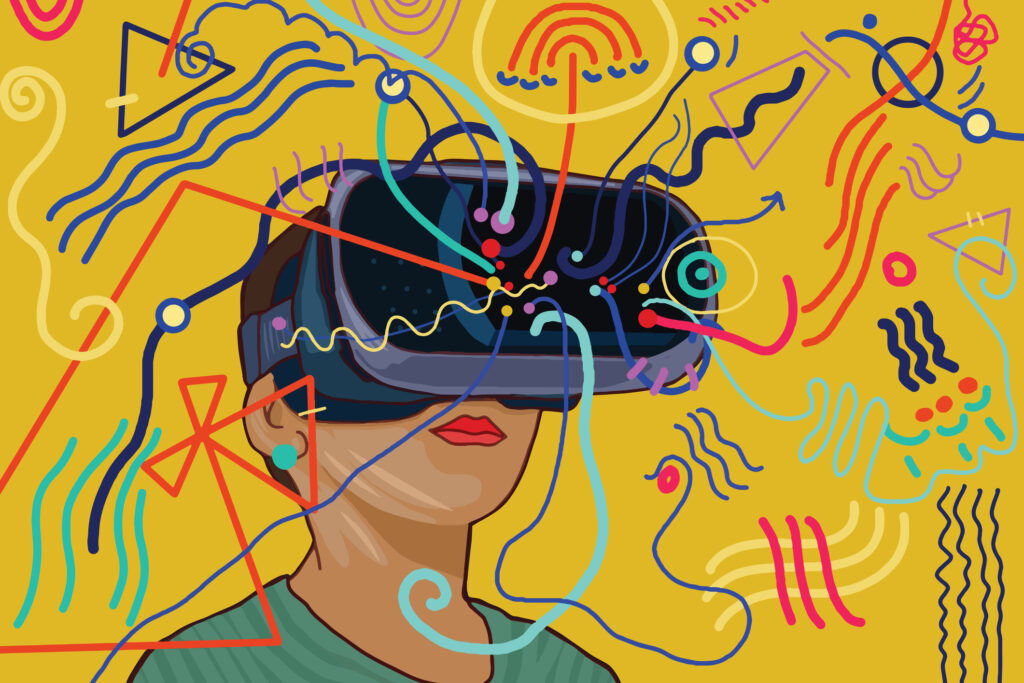Artificial intelligence (AI) has seen a quiet transformation over the past six months. Mainstream technology circles are increasingly dominated by names like ChatGPT, Midjourney, and Google’s promising new tool, Bard.
The ripple effect of this change is causing widespread debates in the education sector.
The reason? These tools offer a range of innovative ways to streamline tasks, boost productivity, and in many instances, significantly reduce the human effort traditionally needed.
Consider this: AI chatbots that create extensive text from a simple prompt. These tools help individuals consolidate complex information or even solve specialized problems in areas like interpersonal communication and economics.
The potential of these technologies has even permeated popular culture. A recent episode of South Park called “Deep Learning” focused on the uses of ChatGPT by the characters of the show, both adults and elementary school children.
As these advanced technologies evolve, they will undoubtedly play an increasingly influential role in education. While many of us have heard the opinions of educational futurists on this matter, it’s essential to consider the perspective of those on the front lines.
So what do educators think about these developments?
A glimpse into the future: Two Michigan school administrators leading the way forward in A.I.
Let me take you on a journey as I sit down with two distinguished education professionals, Matt McCullough, an assistant superintendent, and Ashlie O’Connor, an instructional technology and data specialist.
Both of these educational leaders are driving innovation in Michigan’s educational landscape, committed to exploring safe and effective incorporation of AI into classrooms.
Their perspectives are valuable, not just because they’re interesting to read. After all, it’s the hands-on experience with emerging AI tools from our educators that will play a pivotal role in shaping the future of education.
As educators such as McCullough and O’Connor influence the adoption of AI tools in classrooms, their insights will inform critical decisions made across the nation concerning using AI tools in education.
With this in mind, I carried out two detailed interviews designed to explore their thoughts about AI’s role in education and their personal experiences with AI. The interviews were semi-structured, leaving room for open discussion and discovery.
Here are the five key insights gleaned from these interviews:
#1 — AI in classrooms: Fostering creativity and independent thinking
Let’s dive deeper into one of the themes that emerged from my conversations with McCullough and O’Connor. Both envision AI as a tool and a catalyst that could revolutionize how we engage with education.
They highlighted a compelling point: AI has the potential to nurture independent learners and thinkers, and it can stoke the fires of creativity in ways we haven’t even begun to imagine.
The implications of this shift could be profound.
As O’Connor insightfully put it, “AI can transform education by creating independent learners and thinkers and enhancing creativity in ways beyond measure.”
But the power of AI goes beyond cultivating intellect and creativity.
According to McCullough and O’Connor, AI-assisted learning could also empower students with critical skills in the 21st-century workforce. Think of qualities like resilience, adaptability, and the ability to receive feedback constructively – skills that today’s employers highly value.
What’s more, they pointed out that AI’s proficiency at identifying problems could free human minds to concentrate on devising solutions and implementing them effectively.
#2 — The digital co-teacher: ChatGPT’s potential in transforming the education landscape
Diving deeper into our discussion, McCullough and O’Connor shared their experiences with one of the rising stars in AI: ChatGPT. Their insights reveal how this innovative tool may play a pivotal role in education, particularly in English Language Arts (ELA).
Imagine a tool that isn’t just a learning aid but a partner in developing writing, literacy, and information-processing skills.
According to O’Connor, that’s precisely the potential that ChatGPT presents. “ChatGPT can revolutionize the way students learn and write essays,” she said. It’s not just about churning out words on a page but offering templates, providing constructive critique, and elevating student engagement and motivation.
As she aptly pointed out, “ELA finally has its own calculator.”
But students aren’t the only ones who stand to benefit from ChatGPT. Our discussions also explored the impact of this AI tool on educators, particularly in terms of content creation.
ChatGPT could dramatically enhance lesson planning, encouraging educators to design lessons that promote critical thinking and analysis.
McCullough captured the sentiment perfectly, noting, “Administrators are excited and curious about ChatGPT introduced to it as a teaching tool… How could it be used to teach those higher-order thinking skills at the top of Bloom’s?”
In essence, ChatGPT isn’t just a tool for the present; it’s a catalyst for change, reshaping how we think about the teaching and learning of the future.
#3 — Navigating the roadblocks: Overcoming resistance to AI in education
As our conversation progressed, McCullough and O’Connor acknowledged an essential roadblock in AI’s journey into the classroom: resistance to change.
Interestingly, they perceive that the resistance that their peers are experiencing isn’t due to unfamiliarity or lack of understanding. Instead, it’s rooted in concerns about academic integrity.
Both professionals shared their experiences of colleges and K-12 schools being hesitant to embrace or even allow ChatGPT.
The common apprehension? Cheating and plagiarism.
Many educators fear that students could misuse this AI tool, jeopardizing the academic honesty at the heart of education.
However, both McCullough and O’Connor take a different perspective on this issue. They agreed that the advent of AI might seem like a shortcut to success for some students.
Still, they argue, the challenge lies not in controlling the tools that students have access to but in evolving how we assess and challenge learners in the first place.
As O’Connor wisely pointed out, “Some schools have been resistant to using ChatGPT due to fears and automatic firewalls that block student accounts. However, I believe that we are only in year 0 of AI development and that AI will continue to change and improve education.”
This view reflects their shared belief that the technology is poised for mainstream adoption. While education often lags in embracing significant technological advances, they argue that there’s more to gain by learning and adapting quickly rather than shying away.
#4 — Tailored to you: AI as the ultimate tool for differentiation
As we ventured further into the realm of AI in education, a fascinating conversation thread emerged: AI’s potentiality for personalizing student learning.
According to McCullough and O’Connor, AI holds significant potential to tailor learning experiences, catering to each student’s unique abilities, interests, and learning pathways.
Imagine AI crafting a unique learning experience tailored to each student, freeing up teachers to evaluate student questions and work with more detail.
This shift propels teachers from being mere information conduits to becoming true facilitators of knowledge exploration.
Even though AI-powered chatbots like ChatGPT dazzle us with their ability to compile and display information almost instantaneously, they cannot mimic the sophisticated, higher-order teaching talents that skilled educators bring to the table.
Moreover, teachers could leverage these AI tools to create individualized assignments, develop interest-specific content, and assess student work against a robust rubric.
As both participants predicted, such an approach offers the promise of maximized efficiency and resource utilization, leading to improved student outcomes.
O’Connor eloquently highlighted this vision, stating, “AI has the potential to personalize the learning experience for students in a more effective way than traditional classroom methods… It’s like Google 2.0 and Library 3.0… it can be used for ultimate differentiation.”
#5 — Treading carefully: Ethical implications of AI in the classroom
In their thoughtful deliberations, both interviewees highlighted the ethical considerations required when implementing AI into classrooms.
They acknowledged the possibility of AI becoming a double-edged sword.
On the one hand, it could propel those with access and knowledge to succeed quickly. On the other, it could widen the education gap for those less privileged or less prepared to harness its strengths.
In O’Connor’s words, “There needs to be transparency and accountability in using AI, with a keen focus on equity and inclusion. We must ensure that every student reaps the benefits of this technology. It’s crucial to be vigilant about the potential biases and disparities that AI might perpetuate and strive to alleviate them.”
The participants also offered a word of caution: ChatGPT and similar tools should complement, not replace, traditional teaching for foundational skills like reading and arithmetic.
Their concern? The overuse of AI risks reducing education to a mere cycle of information digestion and regurgitation, void of critical application.
They reiterated that an adept teacher who deeply understands their students’ strengths, weaknesses, and past knowledge will always outshine AI in fostering inquiry, new knowledge formation, and skill-building.
Both interviewees unequivocally rejected the idea of AI as a mere busywork generator, a facilitator of lower-order thinking, or a creator of meaningless ‘work.’
Rather, they viewed any such overdependence on AI as a deviation from the ethical standards of teaching.
Embracing the AI revolution: A thoughtful outlook
When you consider the insights shared by these education innovators, a clear image begins to form. They envision a future where AI belongs in classrooms and actively enriches the learning experience. They see the vast potential of tools like ChatGPT and believe that early and proactive adaptation is the key to successfully integrating these technologies.
Yet, this optimism comes with a firm grasp of reality.
Both participants understand that these powerful tools could present challenges if teaching and assessment methods remain stagnant. They advocate for change and believe that as AI transforms education, the role of the educator should evolve to keep pace.
Furthermore, they understand the necessity of safeguards and policies to ensure the fair and equitable use of AI in education.
While McCullough and O’Connor represent a fraction of Michigan’s educational landscape, their insights are significant.
Reflections like theirs — grounded in years of educational experience and hands-on exploration of emerging AI tools — will shape future adoption processes and decision-making in many schools.
Their commitment to safely incorporating AI into classrooms for teachers and students sets an encouraging precedent.
As we look forward to a future enhanced by AI, it’s vital for educators to stay informed. If you are an educator looking for more information on ChatGPT, check out this professional learning course.
Want a deeper dive into how AI can be used for curriculum development? Check out this article, and stay tuned for emerging research on AI in education by subscribing to our blog.

